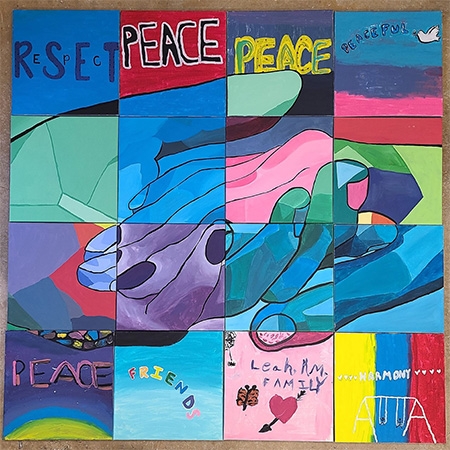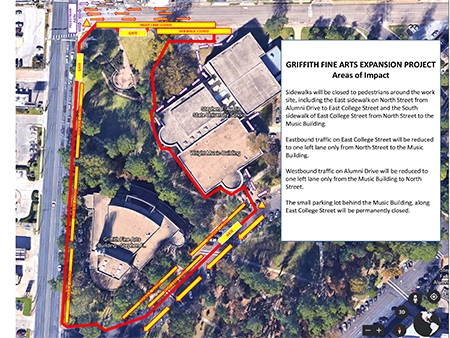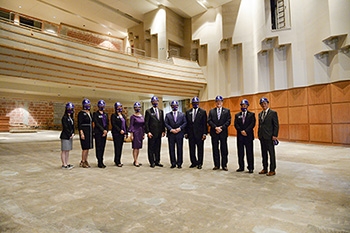SFA University
November 19, 2020 - For the second consecutive year, the Society of American Foresters recognized the Stephen F. Austin State University student chapter among the top three in the nation during the organization’s virtual conference held in October.
“Winning this award for the second year in a row is very gratifying,” said Jacob Muggeridge, forestry major and president of the SFA student chapter. “I hope we can continue the tradition this upcoming year with further events and engagement in the spring semester.”
The recognition is based on the accomplishments of the student chapter, as well as its service to the community.
Muggeridge said that with the guidance of Dr. Rebecca Kidd, assistant professor of forest ecology and SAF student chapter faculty advisor, the chapter actively built and maintained relationships with local groups, such as the Angelina-Nacogdoches Forest Landowners Association, and conducted a number of service projects with Mission Tejas State Park and the Pineywoods Native Plant Center.
“Through Dr. Rebecca Kidd’s leadership, student members of the SFA student chapter of the SAF have developed an exemplary record of service to the forestry profession and the East Texas community,” said Dr. Hans Williams, dean of SFA’s Arthur Temple College of Forestry and Agriculture. “They are outstanding ambassadors for the SFA forestry program and deserving of this national recognition.”
November 13, 2020 - Art education students at Stephen F. Austin State University are continuing to explore new and innovative ways to teach art to members of the Boys and Girls Club of Deep East Texas.
In another collaborative effort, the SFA School of Art, the Boys and Girls Club and the Community Arts Center of East Texas helped students create a colorful mural completely online.

This colorful mural was created online by art education majors at SFA and student artist participants of the Boys and Girls Club of Deep East Texas. It will be displayed at the Judy B. McDonald Public Library in Nacogdoches.
“In weekly Zoom meetings, art education students conducted one-on-one tutorial painting sessions with Boys and Girls Club participants in which each student painted a square of a graphed image,” explained Dr. Maggie Leysath, professor of art education at SFA.
Boys and Girls Club children discussed the meaning of “intercultural harmony" and created images that reflected their ideas. Art education students took those ideas and created a central image of helping hands.
“The final result is a collaborative image that highlights the individuals who created it,” Leysath said, “and, it was completely done from remote locations.
“Well done future art educators,” she added, “and a big, huge thank you to everyone at the Boys and Girls Club and the awesome Community Arts Center of East Texas.”
The mural is being installed for viewing at the Judy B. McDonald Public Library in Nacogdoches.
For more information about the School of Art, call (936) 468-4804 or visit art.sfasu.edu.
November 9, 2020 - Educators wanting to further their careers can now earn a doctorate in educational leadership without leaving their hometowns through a new online program in the James I. Perkins College of Education at Stephen F. Austin State University.
“This is the first completely online doctoral degree offered by SFA,” said Dr. Stacy Hendricks, coordinator for the educational leadership doctoral program and associate dean in the Perkins College of Education. “It is designed for those who are fully employed in school districts or other educational agencies. They can participate in the program while meeting their job and family commitments.”
The Doctor of Education in educational leadership prepares K-12 and higher education leaders to address population growth issues, cultural diversity, policy analysis and design, problem-solving and the change process through content-specific coursework and summer field-based leadership internships.
The program features 66 hours of challenging, relevant curriculum taught using a cohort design with collegial support. Participants can specialize in specific content areas to become institutional and agency researchers, curriculum specialists and K-12 leaders, among other roles.
Some program participants progress into nonacademic college and university administrator positions.
“Though this degree does not automatically make you eligible to become a faculty member or an academic leader, such as a unit head, dean or provost, you can pursue academic leadership opportunities with the appropriate faculty qualifications and experience,” Hendricks said.
The deadline to apply for the program is March 15, and the new cohort begins May 17.
For more information, email Hendricks at edd@sfasu.edu or visit sfasu.edu/sfaonline.
November 3, 2020 - Registration for spring 2021 at Stephen F. Austin State University will begin Monday, Nov. 9, as campus faculty, staff and administrators gear up to offer another safe and highly flexible academic semester.
The spring 2021 semester at SFA is expected to operate much like fall 2020, according to Dr. Scott Gordon, SFA president.
“If we continue to do the right things, we will be able to operate as close to normal as possible in the spring,” he said. “Our campus community has been very resilient in the face of the COVID-19 pandemic, but we can’t let our guard down now. We will need to continue to pay attention to the three Ws — watching our distance, wearing our masks and washing our hands."
Spring classes start Friday, Jan. 8. The university decided to begin the spring semester earlier than normal to accommodate for its newer, flexible eight-week sessions. These shortened terms allow students to earn the same number of credit hours for one class in half the amount of weeks as a regular semester.
Students can take both eight-week and traditional 16-week courses at the same time, making it easier for students to fulfill SFA’s “15 to Finish” initiative, which encourages students to take 15 credit hours per semester. This allows students to graduate in less time than the national average and can save a student thousands of dollars during the course of four years.
Delivery methods for spring classes will remain just as flexible as they were in the fall. Classes will continue to be offered in face-to-face, online, livestream, hybrid or hyflex formats, and distance-learning opportunities continue to expand.
Faculty members choose the modality of their courses, and students are able to select the course delivery types that best fit their needs.
“The spring and fall 2020 semesters were a true test of SFA’s ability to evolve on the spot, and our faculty, staff and administrators met that challenge with strength, transitioning thousands of courses to remote learning formats in a matter of weeks,” said Dr. Steve Bullard, SFA provost. “However, we understand students are still dealing with a lot of change and uncertainty, so we continued to expand those offerings throughout the fall and are excited to have versatile course options again in the spring.”
At present, the breakdown of available spring course modalities, including both undergraduate- and graduate-level courses, is 41% hybrid, 31% face-to-face, 21% fully online and 6% livestream.
SFA also will continue to offer test-optional admissions for all 2021 semesters — a decision prompted by the cancellation of SAT and ACT exam administration at testing centers across the state that are struggling to accommodate test participants due to required physical distancing standards.
While the test score requirement is lifted for the admission process, students who were able to take the SAT or ACT are encouraged to submit those scores with their ApplyTexas application as they may be needed in the scholarship review process.
Administrators feel positive about the success of the fall semester, despite steep state-level budget cuts across a number of sectors.
Fall 2020 enrollment numbers were much better than many educational forecasts predicted based on impacts of the pandemic. Fall enrollment at SFA totaled 12,620 students, a decrease of 349 students, or 2.7%. However, there was a 10.7% increase in SFA’s graduate enrollment, from 1,475 students in fall 2019 to 1,633 students in fall 2020.
SFA administrators were especially pleased with fall retention rates, which indicate a potential 7% increase, from 70% in fall 2019 to 77% this fall.
The university will continue to support students and employees in the spring through use of on-campus signage promoting physical distancing guidelines and ways to safely interact with others.
Safety measures implemented in the fall that will continue in the spring include:
- regular sanitizing of high-touch-point areas in all campus buildings
- reduced seating capacity in classrooms to help ensure proper physical distancing based on the room’s square footage
- available use of hand-sanitizing stations in buildings across campus
- touchless service in all dining halls
- and physically distanced workout equipment in the Student Recreation Center to help ensure Lumberjacks continue to have an outlet for mental and physical health.
For more information, visit our Spring 2021 Guide at sfasu.edu/spring2021.
November 2, 2020 - Stephen F. Austin State University’s horticulture program will host an annual fall plant sale from 11:30 a.m. to 5 p.m. Friday, Nov. 6, at the SFA Plantery, located at 1924 Wilson Drive.
Plants available for purchase include a variety of winter annuals, such as pansies, violas, wallflowers, sweet alyssum and snapdragons. All plants are winter hardy and grow well in East Texas. Plants are $2 per pot or $32 for a tray of 18 plants.
“The students are so excited to sell great plants to our community,” said Dr. Jared Barnes, associate professor of horticulture and steward of the Plantery. “More and more research has shown that people have turned to gardening this year to relieve stress and anxiety, and we are happy to provide plants that enrich people’s lives.”
The plant sale will be held outdoors and follow university protocols for physical distancing and safety. All attendees must wear masks and are encouraged to bring exact change or a check.
Attendees also may opt for in-car pick up. Those who wish to do so are encouraged to email the Plantery for a list of available plants. Pick-up orders will be accepted until 5 p.m. Thursday, Nov. 5.
For more information, contact Barnes at sfahorticulture@gmail.com. To learn more about SFA’s horticulture program, visit www.horticultureisawesome.com/the-plantery or follow @sfahorticulture on Instagram.
Stephen F. Austin State University’s horticulture program will host an annual fall plant sale from 11:30 a.m. to 5 p.m. Friday, Nov. 6, at the SFA Plantery, located at 1924 Wilson Drive. Pictured, SFA horticulture students tend to winter annuals grown at the Plantery.
October 30, 2020 - Stephen F. Austin State University has partnered with Texas A&M University System’s RELLIS Academic Alliance to offer a face-to-face completer program for the Bachelor of Science in Interdisciplinary Studies’ early childhood through grade 6 concentration in Bryan-College Station.
This partnership, beginning in fall 2021, will help students from Blinn College District and other institutions seamlessly transition into the SFA program.
“The SFA campus and the RELLIS Academic Alliance share a very important goal: We want to reshape education to meet the needs of our Texas students,” said Dr. Scott Gordon, SFA president. “The RELLIS Campus is a tremendous model where multiple institutions are offering programs in one location. That’s innovation, and innovation is the key to success.”
With its focus on early childhood and reading education preparation as well as extensive field experiences, the BSIS with the EC-6 concentration has a strong reputation for developing future teachers’ knowledge and skills in education with courses that provide real-world experience working with children.
“As a regional university, SFA has a historically strong reputation for helping to fill the employment needs of the area by providing access to high-quality educational opportunities,” said Dr. Judy Abbott, dean of SFA’s James I. Perkins College of Education. “Bringing our showcase degree, the BSIS, to the RELLIS Academic Alliance provides access for Bryan-College Station area students to a well-established and respected educator preparation program.”
SFA is the first institution outside the Texas A&M University System to be invited to offer a bachelor’s degree within the RELLIS Academic Alliance.
“We are proud to partner with SFA to offer an established, quality education program to our students at RELLIS,” said Texas A&M University System Chancellor John Sharp. “I have no doubt this program will be an asset to the Academic Alliance and future students. We think it’s going to become one of the fastest growing offerings that we have.”
Abbott hopes this partnership will help address the shortage of certified teachers for the state’s public schools.
“The Bachelor of Science in Interdisciplinary Studies is the most frequently awarded degree at SFA, so this opportunity to bring the BSIS to the RELLIS Academic Alliance is remarkable,” Abbott said. “We are excited to become a partner in the RELLIS Academic Alliance and to increase the development of teacher education students eligible to become certified and step into the classrooms of Texas schools.”
Students seeking to enroll in the BSIS completer program may apply for SFA’s community college transfer scholarship. This funding opportunity offers students transferring from a community college $1,000 per year if the student’s GPA is 3.0 to 3.49, or $2,000 per year if the student’s GPA is above 3.50. To be eligible, students must have at least 45 transferable hours.
About the RELLIS Academic Alliance
With the addition of the education program, the RELLIS Academic Alliance offers 26 unique academic options from 10 Texas A&M System regional universities and Stephen F. Austin State University. Program options include degrees in a variety of fields, including technology and engineering, business and industry, natural and human sciences and public service. For more information about the RELLIS Academic Alliance, visit rellis.tamus.edu/academicalliance.
About the RELLIS Campus
Founded in 2016 by the Texas A&M University System, the RELLIS Campus in Bryan fosters cutting-edge research, technology development, workforce training and two- and four-year college degrees by tapping the system’s state agencies and multiple universities, along with academic, corporate and government partners outside the system.
For more information, visit sfasu.edu/rellis.
Stephen F. Austin State University has partnered with Texas A&M University System’s RELLIS Academic Alliance to offer a face-to-face completer program for the Bachelor of Science in Interdisciplinary Studies’ early childhood through grade 6 concentration in Bryan-College Station. The partnership will begin in fall 2021. On hand to make the announcement at SFA were Dr. Jim Nelson, director of the RELLIS Academic Alliance and associate vice chancellor of the Texas A&M University System; Dr. Nancy Jordan, provost of the RELLIS Academic Alliance and associate vice chancellor of the Texas A&M University System; John Sharp, chancellor of the Texas A&M University System; Dr. Scott Gordon, SFA president; and Dr. Steve Bullard, provost and vice president of Academic Affairs at SFA.
October 30, 2020 - Demolition is winding down inside the Griffith Fine Arts Building on the Stephen F. Austin State University campus in conjunction with a fine arts expansion and renovation project that will add nearly 68,000 square feet to the current building.
Phase II of the project – construction/expansion of the building – will soon be underway and is being described by construction officials as “an extensive project” that will start with massive dirt removal, including digging a hole deeper than the current Johnson Coliseum expansion and three times larger.
As a result, motorists and pedestrians in the area should expect construction zone changes that will alter traffic patterns starting next week and continuing for an estimated two years.
Beginning Nov. 3, a construction zone will be established around the Griffith Fine Arts Building that includes the creation of a perimeter fence surrounding the work site. In order to accommodate site preparation and construction, traffic and pedestrian routes in close proximity to the Griffith Fine Arts Building will be impacted. This includes the areas near the intersection of North Street and East College Street, and the parking spaces located along the westbound lane of Alumni Drive. It is anticipated that construction will take up to 24 months, weather permitting. Motorists and pedestrians are urged to use extreme caution in the area, expect minor traffic delays and use alternate routes if possible.
Note the following areas of impact:
- Sidewalks will be closed to pedestrians around the work site, including the east sidewalk on North Street from Alumni Drive to East College Street and the south sidewalk of East College Street from North Street to the Wright Music Building.
- Eastbound traffic on East College Street will be reduced to one left lane only from North Street to the music building.
- Westbound traffic on Alumni Drive will be reduced to one left lane only from the music building to North Street.
- The small parking lot behind the Music Building, along East College Street will be permanently closed for the duration of the project.
The Fine Arts Expansion Initiative will include extensive renovations to the existing Griffith Fine Arts Building and add handicap parking, a patron drop-off zone (off of East College Street) and new construction which will extend the building along North Street nearly to the corner of East College Street. The renovated and expanded state-of-the-art building will include two dance studios, two theatres, a renovated Turner Auditorium and pre-event lobby space, recording studio, sound stage, audio and video editing rooms, an art gallery, multiple classrooms, rehearsal facilities, faculty offices and the offices of the College of Fine Arts dean. The facilities will house the CFA’s sound recording technology, filmmaking, theatre, dance and musical theatre programs.
Renovation to the existing building and new construction will be underway simultaneously. New construction of 67,905 square feet will bring the total building space to 137,374 square feet.
The anticipated construction will help ease the need for additional space to accommodate continued growth in the College of Fine Arts, according to Dr. A.C. “Buddy” Himes, dean, who has repeatedly stated for many years in his Southern Association of Colleges and Schools’ assessment report: “Only through construction of additional facilities will the College of Fine Arts be able to fully alleviate concerns for space, grow to its potential in enrollment, be competitive with similar programs in Texas, and fully capitalize upon student markets for new programs.”
“Now, this is coming to fruition,” Himes said. “The lesson to be learned is to develop your vision, articulate this clearly for all to see and understand, and never lose sight of this no matter what obstacles may occur.”
Questions or concerns about construction may be directed to the Physical Plant Department Work Control at (936) 468-3206 or the University Police Department at (936) 468-2608.
Beginning Nov. 3, a construction zone will be established around the Griffith Fine Arts Building on the SFA campus that includes the creation of a perimeter fence surrounding the work site.

A portion of traffic lanes along Alumni Drive on the SFA campus and East College Street will be affected by the expansion of Griffith Fine Arts Building. (Aerial Map)
If approved, funding would be used to establish collaborative research center
October 28, 2020 - An effort by Stephen F. Austin State University to establish the Center for Applied Research and Rural Innovation – where faculty, staff and students can engage in research development projects that support academic programs and boost regional economic development – began Monday with the approval by the Board of Regents of a $3.57 million Economic Development Administration grant application to provide a physical location for the center.
“When you bring people from disparate disciplines and backgrounds together, new ideas, products and solutions to problems emerge that would never have occurred otherwise,” said Dr. Scott Gordon, SFA president. “In whatever business or industry it may be, bringing people together with SFA’s outstanding faculty and students to form research teams around problem-solving – great things will happen. New ideas and new products and technologies can be developed, and we want to be on the forefront of this innovation.”
Regents also ratified the 2022-23 Legislative Appropriations Request, which includes funding for an Agriculture and Technology Complex, an Interdisciplinary and Applied Sciences Building, and operational funding for the Center for Applied Research and Rural Innovation.
The grandstands recently constructed at the SFA Soccer Field near the corner of Wilson Drive and Starr Avenue will be known as the Joe and Frances Atkinson Family Grandstands, based on the board’s approval of a donation from the Mary Frances Atkinson Charitable Trust in support of the SFA women's soccer program. The stands include a premium suite area and have allowed SFA Athletics to sell soccer season tickets to the public for the first time in program history.
Regents also approved multi-year grant awards for FY20 and FY21. Grant awards for FY21 total $5.56 million.
The regents heard reports from the Faculty Senate and the Student Government Association.
The board also:
- ratified a contract amendment with Vivature for medical billing services;
- approved an updated holiday schedule for FY21;
- extended the contract for completion of FY20 website development;
- approved policy revisions and the annual audit report and internal audit charter;
- and approved the minutes of previous meetings.
Four faculty members were approved by regents to fulfill interim leadership roles, including Chay Runnels, interim director, human sciences; Luis Aguerrevere, interim chair, human services; James Langford, interim chair, biology; and Matthew Beauregard, interim chair, physics, engineering and astronomy. Regents appointed William Davis visiting assistant professor of education studies in the Perkins College of Education.
Other faculty promotions included Victoria Wagner-Greene, assistant professor of kinesiology and health science, and Heather Munro, assistant professor of human services. In Languages, Cultures and Communications, Kathleen McGough, adjunct faculty, was approved as lecturer, and Michael Welsh, lecturer, was approved as associate professor.
Judith Kruwell, human resources interim director, was approved as associate vice president for finance and administrative services, and John Wyatt, associate director, was approved to serve as interim director of Human Resources.
Other appointments included Garret Ashabranner, broiler research center supervisor; Evan Amstutz, assistant volleyball coach; and Lionel Nau, assistant track coach.
Michara DeLaney-Fields, former assistant dean, was approved as chief diversity officer for the university. Alex Reisinger, former admissions coordinator, was approved as Axe Handle One Stop supervisor.
Regents approved changes of status for Megan Weatherly, from instructional design coordinator to director of the Center for Teaching and Learning, and Jana Redfield, from assistant director to associate director of the STEM Research and Learning Center. In the University Police Department, Craig Goodman was promoted from assistant chief to deputy chief of police.
In Residence Life, regents approved Carla Chumley as assistant director business operations and Donna Hammond as assistant director resident services.
In the Office of Student Rights and Responsibilities, Dennis Mosely was approved as director, and Amanda Smith was approved as coordinator.
Regents named Jere Jackson as Professor Emeritus of history and approved the following changes of status:
- Kara Carpenter, from assistant director to associate director, Athletics compliance;
- Jane Ann Bridges, from assistant director to assistant executive chief of Audit Services;
- Dorothy Tubbs, from project coordinator to project director, Counseling Services;
- Morgan Smith, from senior analyst to associate director, Institutional Research;
- Brittany Beck, from admissions coordinator to director, Orientation;
- Jessica DeWitt, from project manager to assistant director, Physical Plant;
- Nick Stallworth, from associate director to director, Student Center;
- Daphne Curl, from manager to director, Testing Services;
- and Amanda Pruit, from director to coordinator, Title IX.

Members of the Stephen F. Austin State University Board of Regents toured campus construction areas during the group’s October quarterly meeting. Pictured in the now-empty Turner Auditorium are, from left, Ireland Bramhall, student regent from Ennis; Brigettee Carnes Henderson and Jennifer Wade Winston, both of Lufkin; Karen Gantt, vice chair of the board from McKinney; Judy Larson Olson of The Woodlands; M. Thomas Mason, board secretary from Dallas; Dr. Scott Gordon, SFA president; Alton Frailey, board chair from Katy; Dr. Scott Coleman of Houston; and Robert Flores and David Alders, both of Nacogdoches.
October 23, 2020 - The Stephen F. Austin State University School of Theatre will present the student-directed one-act play “The Bald Soprano” at 7:30pm Friday, Oct. 30, and at 2pm and 7:30pm Saturday, Oct.31, in Regents Suite A in the Baker Pattillo Student Center on the SFA campus.The show will also be livestreamed.
Directed by Sulphur Springs senior Kaitlyn McDearmont, “The Bald Soprano” is an absurdist play written by Eugène Ionesco. The story line follows a proper English couple, the Smiths, who are sharing an evening with the Martins. The play was inspired by Ionesco’s attempt to learn English, and the dialogue is a parody of the kinds of conversations and take place in foreign-language instruction. The couples, eventually joined by the Fire Chiefand his lover, who is also the Smiths’ maid, tell stories about their lives.
The cast includes San Antonio freshman Hannah Marfin as Mrs.Smith; Ferris senior Cameron Ralston as Mr. Smith; Mount Enterprise sophomore Mikayla Whitlow as Mary; Houston junior Johana Lenington as Mrs. Martin; Center sophomore Keaton Watlington as Mr. Martin; and Red Oak senior Sedona McDonaldas Fire Chief.
Stage manager is Valeria De La Cruz, Zacatecas, Mexico,senior; scenic designer is Jenna Alley, Kingwood junior; costume designer isCairo Pratt, Scurry junior; lighting designer is CaitLyne Martin, Brownsborojunior; and sound designer is Carson Cook, McKinney junior.
McDearmont is a theatre education major. As an SFA student,she lists her favorite shows with which she has been affiliated as “The Wolves,” in which she acted as assistant director; “Dancing at Lughnasa,” for which she was props master; and “Crimes of the Heart,” in which she acted in the role of Babe.
Faculty production advisor for “The Bald Soprano” is Rick Jones.
Tickets are $4. To purchase tickets or virtual access, visit the SFA Fine Arts Box Office online at boxoffice.sfasu.edu or call(936) 468-6407. Box office sales end at 4pm on Oct. 30. For more information about the play, call the School of Theatre at (936) 468-4003 or visit theatre.sfasu.edu.
October 20, 2020 - The Stephen F. Austin State University Office of Multicultural Affairs is hosting “Where We Stand: A Celebration of Native American Heritage” from noon to 1 p.m. Nov. 10 at the Baker Pattillo Student Center Multimedia Room.
The event is free and open to the public, but due to COVID-19 guidelines, only a limited number of people will be allowed to attend in person. Others can participate virtually on Zoom or Instagram Live via OMA’s Instagram page, @omasfa1991.
“This celebration aims to raise awareness about indigenous cultures and their struggles while highlighting actions that students, faculty and community members can take to ensure that the indigenous community is being respected, supported and protected,” said Andrea Flores, OMA student ambassador.
The event features information about tribal communities at the national and local levels.
“We will explore topics related to the foundation of our country, the societal understanding of Native Americans and the tribes local to East Texas,” said Jasmine Hassan, OMA student assistant. “Through our interactive and educational activities, attendees will take away valuable information that we hope will create a positive climate in our community.”
Native American Heritage Month gives American indigenous people the opportunity to express their concerns and find solutions for building bridges of understanding and friendship in their local areas. The celebration also recognizes the significant contributions the first Americans made to establish and grow the United States. Former U.S. President George H. W. Bush established the commemorative month in 1990.
To register to attend in person or via Zoom, visit sfasu.edu/oma.









